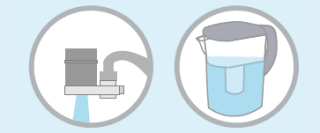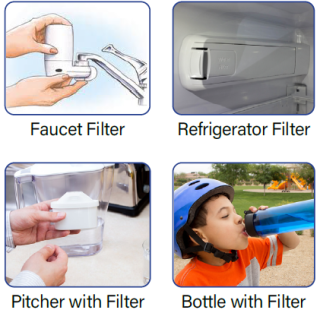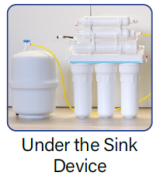Identifying Drinking Water Filters Certified to Reduce PFAS
- Finding a PFAS Drinking Water Filter for Your Home
- How Effective are the Filters?
- What Certifications Should I Look For?
- More Filter Certifications

Per- and polyfluoroalkyl substances, or PFAS, are a group of chemicals that have been widely used in industrial and consumer products and have been shown to cause health issues. Reducing levels of PFAS in your water is an effective way to limit your exposure to these chemicals. Some filters have been certified to remove some PFAS chemicals.
Point-of-use (POU) filters — or a water treatment system used at a single faucet or other fixture — are a relatively inexpensive treatment for reducing PFAS in the home.
Contact your state environmental protection agency or health department and your local water utility to find out what actions they recommend.
Finding a PFAS Drinking Water Filter for Your Home
Granular Activated Carbon (GAC)

Granular activated carbon in a filter traps chemicals as water passes through the material. GAC materials are extremely porous, and the small pores trap the contaminants present in the water.
- $20 - $1,000 (not including maintenance costs).
- Filters have a limited capacity, requiring periodic replacement.
- Contaminants stay captured in the filter, and the filters can be discarded in the trash.
Ion Exchange Resin (IX)
Ion exchange resin is composed of tiny beads that act like powerful ion magnets that attract and hold the contaminated materials from passing through the water system.
- $20-$1,000 (not including maintenance costs).
- Filters have a limited capacity, requiring periodic replacement.
- Contaminants stay captured in the filter, and the filters can be discarded in the trash.
Reverse Osmosis (RO)

Reverse osmosis systems force water through a thin barrier (in typically a three, four, or five stage filtration process) that separates chemicals from the water, creating a stream of treated drinking water and untreated water. The untreated water is sent "down the drain" to septic or municipal sewer systems.
- $150 – $1,000 (not including maintenance costs).
- Requires changing filter cartridges and the RO membrane.
- Cartridges and membrane filters can be discarded in the trash.
- Additional water treatment might be needed depending on your incoming water quality.
- Wastes about one gallon of water per every gallon treated.
How Effective are the Filters?
EPA found that the GAC, IX, and RO point-of-use systems studied can greatly reduce PFAS levels. Filters are only effective if they are maintained according to the manufacturer’s instructions for how long their filters or membranes will last before they need to be replaced.
See the certification information below to learn how to make sure the product you purchase is certified to reduce PFAS.
Learn more in Science Matters: Reducing PFAS in Drinking Water with Treatment Technologies.
It's important to note that the current certification standards for PFAS filters (as of April 2024) do not yet indicate that a filter will remove PFAS down to the levels EPA has now set for a drinking water standard. EPA is working with standard-setting bodies to update their filter certifications to match EPA’s new requirements. In the meantime, remember that reducing levels of PFAS in your water is an effective way to limit your exposure.
What Certifications Should I Look For?
NSF/ANSI 53 for PFAS Reduction
Find certified products with PFAS reduction claims here.
NSF/ANSI 58 for Reverse Osmosis
Find certified reverse osmosis systems here.
When buying a water filter...
-
Look on product labels for certification under NSF/ANSI 53 or NSF/ANSI 58 for PFAS reduction.
-
Look on manufacturer website for certification information or contact them directly.
-
Check NSF website to see if product treats the type of PFAS you’re trying to remove.
Why is certification recommended?
Consumers can purchase filters that have been tested by an accredited third-party certification body. These certifications verify the effectiveness of the filters and accuracy of the contaminant reduction claims.
More Filter Certifications
| Certification Body | Link to Product Listing |
|---|---|
| CSA Group | CSA Group Product Listing |
| IAPMO R&T, Inc. | IAPMO R&T Product Listing Directory |
| NSF | Search for NSF Certified Drinking Water Treatment Units, Water Filters |
| UL | UL Product IQ Search |
| WQA | Find WQA Certified Products |
Please note that any mention of trade names, manufacturers or products does not imply an endorsement by the United States Government or the U.S. Environmental Protection Agency. EPA and its employees do not endorse any commercial products, services or enterprises.
